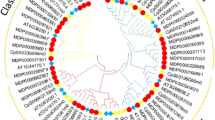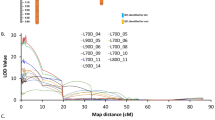Abstract
Tapping panel dryness (TPD) occurrence in high latex yielding rubber tree (Hevea brasiliensis) is characterized by the partial or complete cessation of latex flow upon tapping leading to severe loss in natural rubber production around the world. The goal of this study was to identify genes whose mRNA transcript levels are differentially regulated in rubber tree during the onset of TPD. To isolate TPD responsive genes, two cDNA libraries (forward and reverse) from total RNA isolated from latex of healthy and TPD trees were constructed using suppression subtractive hybridization (SSH) method. In total, 1,079 EST clones were obtained from two cDNA libraries and screened by reverse Northern blot analysis. Screening results revealed that about 352 clones were differentially regulated and they were selected for sequencing. Based on the nucleotide sequence data, the putative functions of cDNA clones were predicted by BLASTX/BLASTN analysis. Among these, 64 were genes whose function had been previously identified while the remaining clones were genes with either unknown protein function or insignificant similarity to other protein/DNA/EST sequences in existing databases. RT-PCR analysis was carried out to validate the up-regulated genes from both the libraries. Among them, two genes were strongly down-regulated in TPD trees. The level of mRNA transcripts of these two genes was further examined by conventional Northern and RT-PCR analysis. Results indicated that the expression level of two genes was significantly lower in TPD trees compared to healthy trees. Many TPD associated genes were also up-regulated in TPD trees suggesting that they may be involved in triggering programmed cell death (PCD) during the onset of TPD syndrome. The results presented here demonstrate that SSH technique provides a powerful complementary approach for the identification of TPD related genes from rubber tree.






Similar content being viewed by others
Abbreviations
- TPD:
-
Tapping panel dryness
- SSH:
-
Suppression subtractive hybridization
- PCD:
-
Programmed cell death
- EST:
-
Expressed sequenced tags
- RT-PCR:
-
Reverse transcription polymerase chain reaction
- TCTP:
-
Translationally controlled tumor protein
- ROS:
-
Reactive oxygen species
References
Adiwilaga K, Kush A (1996) Cloning and characterization of cDNA encoding farnesyl diphosphate synthase from rubber tree (Hevea brasiliensis). Plant Mol Biol 30:935–946
Anonymous (2002) Mean yield during the fourth year of tapping. RRII annual report pp 23
Anonymous (2006) World production and consumption of natural rubber. Rub Stat Bull 31:37–38
Bozhkov PV, Suarez MF, Filonova LH, Daniel G, Zamyatnin AAJr, Rodriguez-Nieto S, Zhivotovsky B, Smertenko A (2005) Cysteine protease mcll-Pa executes programmed cell death during plant embryogenesis. Proc Natl Acad Sci USA 102:14463–14468
Chang C, Shockey JA (1999) The ethylene-response pathway: signal perception to gene regulation. Curr Opi Plant Biol 2:352–358
Chen S, Peng S, Huang G, Wu K, Fu X, Chen Z (2003) Association of decreased expression of a Myb transcription factor with the TPD (tapping panel dryness) syndrome in Hevea brasiliensis. Plant Mol Biol 51:51–58
Chrestin, H (1989) Biochemical aspects of bark dryness induced by over stimulation of rubber tree with Ethrel. In: d’Auzac J, Jacob JL, Chrestin H (eds) Physiology of rubber tree latex. CRC Press, Boca Raton, pp 341–441
Darussamin A, Suharyanto S, Chaidamsari T (1995) Change in the chemical composition and electrophoretic profile of latex and bark protein related to tapping panel dryness incidence in Hevea brasiliensis. Menara Perkebunan 63:52–59
Degenhardt J, Al-Masri AN, Kurkcuoglu S, Szankowski I, Gau AE (2005) Characterization by suppression subtractive hybridization of transcripts that are differentially expressed in leaves of apple scab-resistant and susceptible cultivars of Malus domestica. Mol Gen Genom 273:326–335
Dian K, Sangare A, Diopoh JK (1995) Evidence for specific variation of protein pattern during tapping panel dryness condition development in Hevea brasiliensis. Plant Sci 105:207–216
Diantchenko L, Lukyanov S, Chris Lau Y-F, Siebert PD (1999) Suppression subtractive hybridization: a versatile method for identifying differentially expressed genes. Meth Enzymol 303:349–380
Dietrich RA, Richberg MH, Schmidt R, Dean C, Dangl JL (1997) A novel zinc finger protein is encoded by the Arabidopsis LSD1 gene and functions as a negative regulator of cell death. Cell 88:685–694
Eastmond PJ, Graham IA (2001) Re-examining the role of the glyoxylate cycle in oilseeds. Trends Plant Sci 6:72–77
Ermolayev V, Weschke W, Manteuffel R (2003) Comparison of Al-induced gene expression in sensitive and tolerant soybean cultivars. J Exp Bot 54:2745–2756
Fan XW, Yang SQ (1994) Cause of disease and hypothesis on tapping panel dryness of Hevea brasiliensis. China J Trop Crops Res 18:43–48
Faridah Y, Siti, Arija MA, Ghandimathi H (1996) Changes in some physiological latex parameters in relation to over exploitation and onset of induced tapping panel dryness. J Nat Rubber Res 10:182–186
Gechev T, Gadjev I, Hille J (2004) An extensive microarray analysis of AAL-toxin-induced cell death in Arabidopsis thaliana brings new insights into the complexity of programmed cell death in plants. Cell Mol Life Sci 61:1185–1197
Han KH, Shin DH, Yang J, Kim IJ, Oh SK, Chow KS (2000) Genes expressed in the latex of Hevea brasiliensis. Tree Physiol 20:503–510
Heath MC (2000) Hypersensitive response-related death. Plant Mol Biol 44:321–334
Hellmann H, Estelle M (2002) Plant development: regulation by protein degradation. Science 297:793–797
Jacob JL, Prevot JC, Laccrotte R (1994) Tapping panel dryness in Hevea brasiliensis. Plant Rech Dev 2:15–21
Kang J-G, Yun J, Song P-S, Park C-M (2005) Transgenic plant transformed with a translationally controlled tumor protein (TCTP) gene. US patent No. US6, 0946,294 B2
Kost B, Lemichez E, Spielhofer P, Hong Y, Tolias K, Carpenter C, Chua N-H (1999) Rac homologues and compartmentalized phosphatidylinositol 4, 5 bisphosphate act in a common pathway to regulate polar pollen tube growth. J Cell Biol 145:317–330
Krishnakumar R, Sasidhar VR, Sethuraj MR (1997) Influence of TPD on cytokinin level in Hevea bark. Ind J Nat Rubber Res 10:107–109
Krishnakumar R, Shreelatha S, Thomas M, Gopalakrishnan J, Jacob JL, Sethuraj MR (1999) Biochemical composition of soft bark tissues in Hevea affected by tapping panel dryness. Ind J Nat Rubber Res 12:92–99
Krishnakumar R, Cornish K, Jacob J (2001a) Rubber biosynthesis in tapping panel dryness affected Hevea trees. J Nat Rubber Res 4:131–139
Krishnakumar R, Annamalainathan K, Jacob J (2001b) Tapping panel dryness syndrome in Hevea increases dark respiration but not ATP status. Ind J Nat Rubber Res 14:14–19
Lacrotte R, Gidrol X, Vichitcholchai N, Pujade-Renaud V, Narangajavana J, Chrestin H (1995) Protein markers of tapping panel dryness. Plant Rech Dev 2:40–45
Lee S, Park J, Lee Y (2003) Phosphatidic acid induces actin polymerization by activating protein kinases in soybean cells. Mol Cells 15:313–319
Leon J, Rojo E, Sanchez-Serrano JJ (2002) Wound signaling in plants. J Exp Bot 52:1–9
Mahalingam R, Gomez-Buitrago A, Eckardt N, Shah N, Guevara-Garcia A, Day P, Raina R, Fedoroff NV (2003) Characterizing the stress/defence transcriptome of Arabidopsis. Genome Biol 4:R20
Mayda E, Tornero P, Conejero V, Vera P (1999) A tomato homeobox gene (HD-zip) is involved in limiting the spread of programmed cell death. Plant J 20:591–600
Paris N, Rogers SW, Jiang L, Kirsch T, Beevers L, Phillips TE, Rogers JC (1997) Molecular cloning and further characterization of a probable plant vacuolar sorting receptor. Plant Physiol 115:29–39
Park J, Gu Y, Lee Y, Yang Z, Lee Y (2004) Phosphatidic acid induces leaf cell death in Arabidopsis by activating the Rho-related small G protein GTPase-mediated pathway of reactive oxygen species generation. Plant Physiol 134:129–136
Pla M, Huguet G, Verdaguer D, Puigderrajols P, Llompart B, Nadal A, Molinas M (1998) Stress proteins co-expressed in suberized and lignified cells and in apical meristems. Plant Sci 139:49–57
del Pozo O, Lam E (1998) Caspases and programmed cell death in the hypersensitive response of plants to pathogens. Curr Biol 8:1129–1132
Premakumari D, Panikkar AON (1992) Anatomy and ultra cytology of latex vessels. In: Sethuraj MR, Mathew NM (eds) Natural rubber: biology, cultivation and technology. Elsevier, Amsterdam
Sambrook J, Fritsch EF, Maniatis T (1989) Molecular cloning: a laboratory manual, 2nd edn. Cold Spring Harbor Laboratory Press, New York
Shinozaki K, Yamaguchi-Shinozaki K (1999) Molecular responses to drought stress. In: Shinozaki K, Yamaguchi-Shinozaki K (eds) Molecular responses to cold, drought, heat and salt stress in higher plants. R.G. Landes, Austin, pp 11–28
Solomon M, Belenghi B, Delledonne M, Menachem E, Levine A (1999) The involvement of cysteine proteases and protease inhibitor genes in the regulation of programmed cell death in plants. Plant Cell 11:431–443
Sookmark U, Pujade-Renaud V, Chrestin H, Lacotem R, Naiyanetr C, Seguin M, Romruensukharom P, Narangajavana J (2002) Characterization of polypeptides accumulated in the latex cytosol of rubber trees affected by the tapping panel dryness syndrome. Plant Cell Physiol 43:1323–1333
Sullivan JA, Shirasu K, Deng XW (2003) The diverse roles of ubiquitin and the 26S proteasome in the life of plants. Nat Rev Gene 4:948–958
Sun W, Van Montagu M, Verbruggen N (2002) Small heat shock proteins and stress tolerance in plants. Biochim Biophys Acta 1577:1–9
Venkatachalam P, Thanseem I, Thulaseedharan A (1999) A rapid and efficient method for isolation of RNA from bark tissues of Hevea brasiliensis. Curr Sci 77(5):101–103
Vinoth T, Premakumari D, Reghu CP, Panikkar AON, Saraswathy Amma CK (1995) Anatomical and histochemical aspects of bark regeneration in Hevea brasiliensis. Ann Bot 75:421–426
Wang C, Zien CA, Afitlhile M, Welti R, Hildebrand DF, Wang X (2000) Involvement of phospholipase D in wound-induced accumulation of jasmonic acid in Arabidopsis. Plant Cell 12:2237–2246
Weston K (1998) Myb proteins in life, death and differentiation. Curr Opin Genet Develop 8:76–81
Wickremasinghe SI, Yapa PAJ, de Soyza TVW (1987) Accumulation of proline in bark and latex of Hevea brasiliensis affected by brown bast. J Rubber Res Inst Sri Lanka 67: 9–17
Xi WX, Xiao XZ (1988) Study on peroxidase isozyme and superoxide dismutase isozyme of TPD Hevea trees. Chin J Trop Crops 9:31–36
Yan SQ, Fan XW (1995) Physiological response of PR107 to intensive tapping with stimulation at early exploitation stage. Chin J Trop Crops 16:17–28
Yasuda E, Ebinuma H, Wabiko H (1997) A novel glycine-rich/hydrophobic 16 kDa polypeptide gene from tobacco: similarity to proline-rich protein genes and its wound-inducible and developmentally regulated expression. Plant Mol Biol 33:667–678
Yusof F, Arija MAS, Ghandimathi H, Hamzah Z, Sivakuraman S, Yeang HY (1995) Changes in some physiological latex parameters in relation to overexploitation and the onset of induced tapping panel dryness. J Natl Rubber Res 10:182–198
Zhang Y, Rouf Mian MA, Chekhovskiy K, So S, Kupfer D, Lai H, Roe BA (2005) Differential gene expression in Festuca under heat stress conditions. J Exp Bot 56:897–907
Acknowledgments
We wish to thank Drs. James Jacob (Director), N.M. Mathew (Former Director) and M.A. Nazeer (Joint Director), Rubber Research Institute of India for their constant encouragement. The authors wish to thank Dr. Anastasios Melis for his valuable suggestions and encouragement during revision of this manuscript.
Author information
Authors and Affiliations
Corresponding author
Rights and permissions
About this article
Cite this article
Venkatachalam, P., Thulaseedharan, A. & Raghothama, K. Identification of expression profiles of tapping panel dryness (TPD) associated genes from the latex of rubber tree (Hevea brasiliensis Muell. Arg.). Planta 226, 499–515 (2007). https://doi.org/10.1007/s00425-007-0500-8
Received:
Accepted:
Published:
Issue Date:
DOI: https://doi.org/10.1007/s00425-007-0500-8




